Cedar Point – Sandusky, Ohio
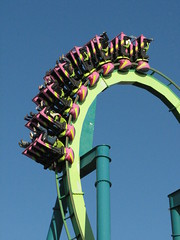 For a B&M inverted roller coaster, Raptor isn’t the most impressive. It’s a rather bland, cookie-cutter set of elements, packed together in a basic B&M spaghetti bowl configuration with a similarly standard color palate and theme. To be sure, it’s big and forceful and definitely one of the ‘must-rides’ of any visit to Cedar Point, each element packing a punch in that special way you could always count on early B&M layouts to do, and it by no means ever disappoints. Raptor could very well be the most consistent crowd-pleaser on the Cedar Point peninsula, without the questionably weak forces and slow timing of Millennium Force, the lack of substance of Top Thrill Dragster, the antiquated roughness and quirk of Magnum, or the free-form uncertainty and persistent neck-choppiness of Maverick (notice I’m not making any statements against any of these rides in one form or another, only that there are certain groups of people that would cite those things as a debilitating negative against each respective ride). Meanwhile, everyone likes Raptor. Okay, occasionally you might hear reports of some Vekoma-like hang-and-banging when the ride’s having a bad day, and for a few others more than one ride could very well leave them feeling sick to their stomach due to the
For a B&M inverted roller coaster, Raptor isn’t the most impressive. It’s a rather bland, cookie-cutter set of elements, packed together in a basic B&M spaghetti bowl configuration with a similarly standard color palate and theme. To be sure, it’s big and forceful and definitely one of the ‘must-rides’ of any visit to Cedar Point, each element packing a punch in that special way you could always count on early B&M layouts to do, and it by no means ever disappoints. Raptor could very well be the most consistent crowd-pleaser on the Cedar Point peninsula, without the questionably weak forces and slow timing of Millennium Force, the lack of substance of Top Thrill Dragster, the antiquated roughness and quirk of Magnum, or the free-form uncertainty and persistent neck-choppiness of Maverick (notice I’m not making any statements against any of these rides in one form or another, only that there are certain groups of people that would cite those things as a debilitating negative against each respective ride). Meanwhile, everyone likes Raptor. Okay, occasionally you might hear reports of some Vekoma-like hang-and-banging when the ride’s having a bad day, and for a few others more than one ride could very well leave them feeling sick to their stomach due to the 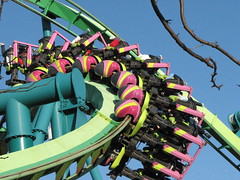 aggressive inversion line-up. But these are quite minor and circumstantial compared to the accusations of some more fundamental problem the Point’s other star attractions are prone to have lobbed at them from time to time. Raptor’s a great ride by nearly any criteria you choose, but creatively it wasn’t a high point for anyone involved, and both B&M and Cedar Point would later go on to have bigger and better ideas.
aggressive inversion line-up. But these are quite minor and circumstantial compared to the accusations of some more fundamental problem the Point’s other star attractions are prone to have lobbed at them from time to time. Raptor’s a great ride by nearly any criteria you choose, but creatively it wasn’t a high point for anyone involved, and both B&M and Cedar Point would later go on to have bigger and better ideas.
Looking backwards along the timeline there was both the super-tight intensity of the Batman rides and Nemesis (the latter of which is still one of B&M’s crowning achievements). Then Raptor was caught in the middle of things as they transitioned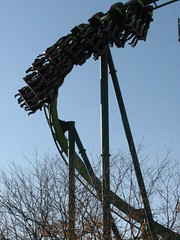 away from tight, compact layouts to much more sprawling and ambitious projects that would become manifest two years later with Busch’s Montu in 1996 and then even further with Alpengeist a year after that. Even then, until the turn of the millennium, B&M continued to experiment with other ideas (or, at the very least, had those ideas presented for them to build), such as the Great Bear’s unique, free-flight helix first drop and river section, Afterburn’s frenetically-paced opening sequencing culminating in a subterranean batwing, or Dueling Dragons with its obvious creative strengths. Even international rides such as Katun or Pyrenees took the basic ideas behind Raptor but improved on them with a larger scale and/or some other uniquely defined element (Pyrenees’ tight helix threading a second large vertical loop inserted between the heartline roll and cobra roll; Katun’s overall larger scope, also featuring a tunnel and a high-speed ground curve). I love Raptor, but on the surface it’s just all a bit too bland and, well, Cedar Fair-ized to outpace any of its above-listed compatriots.
away from tight, compact layouts to much more sprawling and ambitious projects that would become manifest two years later with Busch’s Montu in 1996 and then even further with Alpengeist a year after that. Even then, until the turn of the millennium, B&M continued to experiment with other ideas (or, at the very least, had those ideas presented for them to build), such as the Great Bear’s unique, free-flight helix first drop and river section, Afterburn’s frenetically-paced opening sequencing culminating in a subterranean batwing, or Dueling Dragons with its obvious creative strengths. Even international rides such as Katun or Pyrenees took the basic ideas behind Raptor but improved on them with a larger scale and/or some other uniquely defined element (Pyrenees’ tight helix threading a second large vertical loop inserted between the heartline roll and cobra roll; Katun’s overall larger scope, also featuring a tunnel and a high-speed ground curve). I love Raptor, but on the surface it’s just all a bit too bland and, well, Cedar Fair-ized to outpace any of its above-listed compatriots.
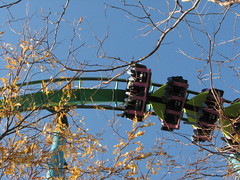 However, writing as a long-time Raptor rider familiar with its every turn, force and shimmy, and having been on more than a few of the alternative titles mentioned above, once I’ve looked past the surface of the type of ride Raptor appears to be and started looking more closely at the details, I will not feel too uncomfortable in claiming that Raptor may very well be B&M’s most successful inverted coaster to date. The only other inverted coaster I’ve not been on (yet) and might hesitate in making that claim is Alton Tower’s Nemesis, and possibly by extension the similarly terrain-insane Black Mamba (but remove the stunning setting and you’ve still got a pretty basic B&M invert layout). Otherwise every other invert I’ve been on has one major downfall, and those I haven’t don’t appear to fix the problem much at all. The problem is this:
However, writing as a long-time Raptor rider familiar with its every turn, force and shimmy, and having been on more than a few of the alternative titles mentioned above, once I’ve looked past the surface of the type of ride Raptor appears to be and started looking more closely at the details, I will not feel too uncomfortable in claiming that Raptor may very well be B&M’s most successful inverted coaster to date. The only other inverted coaster I’ve not been on (yet) and might hesitate in making that claim is Alton Tower’s Nemesis, and possibly by extension the similarly terrain-insane Black Mamba (but remove the stunning setting and you’ve still got a pretty basic B&M invert layout). Otherwise every other invert I’ve been on has one major downfall, and those I haven’t don’t appear to fix the problem much at all. The problem is this: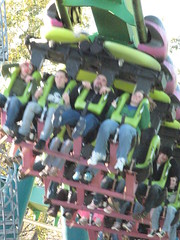
Just about every ride that opens with the Bollinger and Mabillard stamp of creation will inevitably be weaker in the second half than the first. In some cases that’s because the first half is simply strong enough that it sets the bar too high to begin with (Afterburn, Katun), in other cases the second half will start out great but they’re unable to sustain it all the way to the brakes and after the last flat-spin it’ll start to disengage the rider from the experience a few moments too early (Montu, Dueling Dragons, especially Great Bear after the river section and intense flat-spin), and in other cases the entire second half will just be one enormous duff, at least relative to the pre-midcourse block brake section (Alpengeist, Pyrenees). This analysis will extend to nearly any other B&M design as well; if the second half isn’t actively bad, it at least isn’t quite able to match the quality of the first few elements, and this imbalance is always off-putting to me since in dramatic structure you generally want a clear climax rather than steady denouement. Granted nearly every designer has to work hard to avert this problem and will inevitably have several rides in their portfolio that suffer the same fate (it’s a simple fact of coaster design because the friction will inevitably slow the train down over time so the designer must work extra hard to keep the design as fresh and challenging as it began), but B&M are possibly the only major design firm where there are virtually no exceptions to this rule.
One of the few is Raptor.1
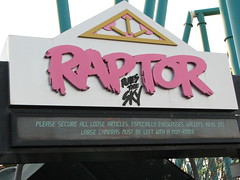 Raptor is the first coaster most people come across when they enter the park in the morning, and it is for that reason that I advise skipping it as your first ride of the day to avoid longer than necessary waits (unless you have an early ride time session, but even then your time is probably better spent on Millennium and Maverick whose queues will generally be longer later in the day anyway) and coming back later in the afternoon when many of the crowds have moved on to elsewhere in the park. Normally I’d include a sentence complaining about the garish paint scheme and poor location choice (all green on a coaster that big and domineering of the main midway’s visual focus?)
Raptor is the first coaster most people come across when they enter the park in the morning, and it is for that reason that I advise skipping it as your first ride of the day to avoid longer than necessary waits (unless you have an early ride time session, but even then your time is probably better spent on Millennium and Maverick whose queues will generally be longer later in the day anyway) and coming back later in the afternoon when many of the crowds have moved on to elsewhere in the park. Normally I’d include a sentence complaining about the garish paint scheme and poor location choice (all green on a coaster that big and domineering of the main midway’s visual focus?)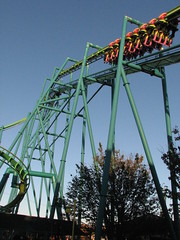 but somehow I don’t seem to mind the aesthetics of the coaster any more, it’s simply part of the whole Cedar Point experience, and if not exactly subtle the green does at least suggests natural foliage so it’s not as inherently attention-grabbing the way a Talon or Silver Bullet color scheme might be. The queue is one of those massive, labyrinthine plots sprawling over the infield sandwiched between the ride’s lift, station, helix finale, and then underneath the break run and filling up the space between it and the Blue Streak as well. With three, 32-passenger trains dispatching every minute or so one hopes they never have to visit on a day when more than a couple of the switchbacks are open, but if they do catch glimpse of a full queue, they should hopefully take solace in the fact that Raptor has probably the second fastest-moving line in the park only after Magnum (Gemini used to be all-time king champion in terms of capacity until they permanently removed a train from both sides; nevertheless it’s still a crowd-eater). I only visit on Friday or Sunday Halloweekends or early season weekdays anymore so my personal tolerance for waits on Raptor has been reduced to not much more than a walk-on.
but somehow I don’t seem to mind the aesthetics of the coaster any more, it’s simply part of the whole Cedar Point experience, and if not exactly subtle the green does at least suggests natural foliage so it’s not as inherently attention-grabbing the way a Talon or Silver Bullet color scheme might be. The queue is one of those massive, labyrinthine plots sprawling over the infield sandwiched between the ride’s lift, station, helix finale, and then underneath the break run and filling up the space between it and the Blue Streak as well. With three, 32-passenger trains dispatching every minute or so one hopes they never have to visit on a day when more than a couple of the switchbacks are open, but if they do catch glimpse of a full queue, they should hopefully take solace in the fact that Raptor has probably the second fastest-moving line in the park only after Magnum (Gemini used to be all-time king champion in terms of capacity until they permanently removed a train from both sides; nevertheless it’s still a crowd-eater). I only visit on Friday or Sunday Halloweekends or early season weekdays anymore so my personal tolerance for waits on Raptor has been reduced to not much more than a walk-on.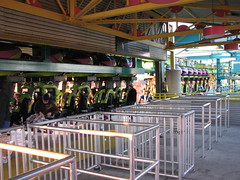
The station floor plan is a pretty minimalist cube with a simple metal roof over it, and a tasteful design aesthetic that balances bright pinks and yellows with a lot of sheet metal. If you’re in a group of two (or even more so, a single rider) be on the lookout for empty spots in the middle rows because there’s not much room or time for people to arrange themselves into groups of four and as a result a lot of empty seats can get sent out due to the rapid pace the trains are dispatched with. The fact that everyone that walks through the ride’s turnstiles wants to wait for the front row only complicates things because they frequently will end up blocking the station entry point for people willing to try other rows. And while popularity in and of itself doesn’t dictate any truths about the 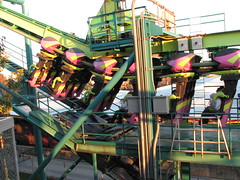 nature of things, it should proffer at least a worthwhile hint at where the best seats in the house are located.
nature of things, it should proffer at least a worthwhile hint at where the best seats in the house are located.
Strapped into our seats the floors drop and front safety gate folds downwards in a way that would have been really cool if the year were 1995. There right curve out of the station has a minor dip to it with a very sharp pullout at the bottom. I’m not sure what this is for other than to advance the speed of the train around this curve. If I’m sitting on the left I can always reach out and touch the car ahead of me; I’ve wondered if the reason for this tight pre-lift dip is to keep the connecting joints between the wheel bogeys and the bases of the cars flexible, but I somehow doubt it. The train rolls up into a flat, pre-lift tire-drive section before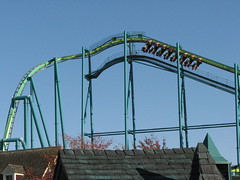 engaging the lift, the noise it makes as it does this is now so imbued with nostalgia in my conscious it’s probably something akin to the sound of the first car you ever owned starting up (or for those of us of a later generation, the sound of a dial-up modem connecting. Well, maybe not really, but I think you get the general idea of what I’m trying to describe with that ‘Raptor engaging the lift’ sound and are just wishing I’d move on with the review already.)
engaging the lift, the noise it makes as it does this is now so imbued with nostalgia in my conscious it’s probably something akin to the sound of the first car you ever owned starting up (or for those of us of a later generation, the sound of a dial-up modem connecting. Well, maybe not really, but I think you get the general idea of what I’m trying to describe with that ‘Raptor engaging the lift’ sound and are just wishing I’d move on with the review already.)
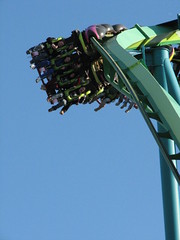 How tall is the lift? The RCDb is telling me 137 feet. That both seems a bit too tall and yet about right. I never think of Raptor as being a very tall coaster (certainly not taller than the 122 ft. tall Shivering Timbers) but whenever I get to the top I still have a moment of surprise to see that the ground and people appear much smaller looking down at them from up here than the riders on the train looked from when I was on the ground. There’s a fast leftward turn over the midway where the sharp rotational motion of the train helps mask the lack of forward-moving motion. On the twist out, if you’re in the back seat, right side in particular, you’ll notice a slight but still very real pop of airtime, something of a rarity to find on a B&M inverted drop. What I find more interesting is the shape of the transition out of the turn and down the drop… is it heartlined? A precursory glance at a photo of it would surprisingly seem to indicate “no”, the boxy spine clearly stays inline while it’s the trains that twist around it back under to the left, instead of the other way around.
How tall is the lift? The RCDb is telling me 137 feet. That both seems a bit too tall and yet about right. I never think of Raptor as being a very tall coaster (certainly not taller than the 122 ft. tall Shivering Timbers) but whenever I get to the top I still have a moment of surprise to see that the ground and people appear much smaller looking down at them from up here than the riders on the train looked from when I was on the ground. There’s a fast leftward turn over the midway where the sharp rotational motion of the train helps mask the lack of forward-moving motion. On the twist out, if you’re in the back seat, right side in particular, you’ll notice a slight but still very real pop of airtime, something of a rarity to find on a B&M inverted drop. What I find more interesting is the shape of the transition out of the turn and down the drop… is it heartlined? A precursory glance at a photo of it would surprisingly seem to indicate “no”, the boxy spine clearly stays inline while it’s the trains that twist around it back under to the left, instead of the other way around.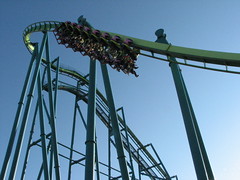 But this hardly makes any sense for B&M to deliberately decide to not design the track around the rider’s heartline for just one section of track, and indeed I think the real answer between the drop’s shape is a bit more deceptive. This first drop I think was actually designed to be an S-curve drop, but because of the heartlining techniques the rightward twist after the lefthand curve remained hidden by the shifting track spine, the only physical result you can see from this path is the slight right curvature remaining on the pullout of the first drop. Between the fast rotation at the very top, pop of airtime on the way down, and hidden s-bend on the way down, this already puts Raptor’s initial plunge at a more interesting level than most other B&M inverts where it’s just one continuous downward twisting motion.
But this hardly makes any sense for B&M to deliberately decide to not design the track around the rider’s heartline for just one section of track, and indeed I think the real answer between the drop’s shape is a bit more deceptive. This first drop I think was actually designed to be an S-curve drop, but because of the heartlining techniques the rightward twist after the lefthand curve remained hidden by the shifting track spine, the only physical result you can see from this path is the slight right curvature remaining on the pullout of the first drop. Between the fast rotation at the very top, pop of airtime on the way down, and hidden s-bend on the way down, this already puts Raptor’s initial plunge at a more interesting level than most other B&M inverts where it’s just one continuous downward twisting motion.
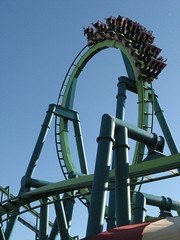 The vertical loop is always a functional element to start the ride with, providing a forceful but uncomplicated heels-over-head moment before moving on to more twisted inversions. The forces are especially strong on Raptor’s, the circumference tight enough to result in tremendously strong positives all the way around the top, but still large enough to last longer than the ultra-quick Batman rides. To be honest I tend to forget about this element when I’m actually riding Raptor, by the time we’ve gotten to the midcourse I’ve all but erased the loop from my short-term memory and I only recall an extension of the strong positives on the pullout of the drop. One other pointless thing I’d like to mention is it’s always appeared to me as though the loop is tipped slightly backwards, so that the tightest part isn’t precisely at the apex. I can’t tell if that’s caused by the lateral shift in the track or the supports not being the same height, but it’s always caused me a moment’s pause whenever I look at it. Just an observation…
The vertical loop is always a functional element to start the ride with, providing a forceful but uncomplicated heels-over-head moment before moving on to more twisted inversions. The forces are especially strong on Raptor’s, the circumference tight enough to result in tremendously strong positives all the way around the top, but still large enough to last longer than the ultra-quick Batman rides. To be honest I tend to forget about this element when I’m actually riding Raptor, by the time we’ve gotten to the midcourse I’ve all but erased the loop from my short-term memory and I only recall an extension of the strong positives on the pullout of the drop. One other pointless thing I’d like to mention is it’s always appeared to me as though the loop is tipped slightly backwards, so that the tightest part isn’t precisely at the apex. I can’t tell if that’s caused by the lateral shift in the track or the supports not being the same height, but it’s always caused me a moment’s pause whenever I look at it. Just an observation…
The zero-g roll that makes up inversion number two is still probably the best B&M ever designed. Admittedly I’ve never been a huge fan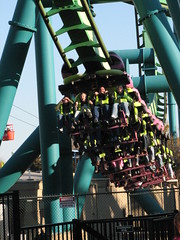 of these maneuvers the way everyone else seems to be, the rotation always being too fast to appreciate it as an inversion while at the same time the weightlessness can be hard to discern because of said rotation (which, unless you happen to be sitting in precisely the middle of the train, will also translate into some laterals). I’m sort of the same way with Raptor’s, which also possesses some of the fastest rotation at the top that B&M would ever design as well. But even this element I like better for a couple reasons: first, it has a slight left tip in the banking before suddenly whipping around to the right at the top; this adds a lot more to the experience than rolls where it’s nothing but a basic pull-up leaving one waiting there passively for the rotation at the top to start. Second, the hill is still large enough to produce some
of these maneuvers the way everyone else seems to be, the rotation always being too fast to appreciate it as an inversion while at the same time the weightlessness can be hard to discern because of said rotation (which, unless you happen to be sitting in precisely the middle of the train, will also translate into some laterals). I’m sort of the same way with Raptor’s, which also possesses some of the fastest rotation at the top that B&M would ever design as well. But even this element I like better for a couple reasons: first, it has a slight left tip in the banking before suddenly whipping around to the right at the top; this adds a lot more to the experience than rolls where it’s nothing but a basic pull-up leaving one waiting there passively for the rotation at the top to start. Second, the hill is still large enough to produce some 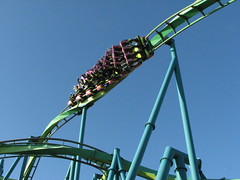 real weightlessness over it while retaining the super-fast rotation that B&M would later slow down; this means that you get more ‘crest’ on the way up or down to enjoy the floater than in cases when the roll is so spread out it starts halfway down the hill. And third, the roll is still just so super-fast and disorienting that it hardly matters if you’re supposed to feel any weightless, I always get a kick sitting on the right side towards the back of the train and watching as the cars ahead sharply bend around the heartline while I’m flung off
real weightlessness over it while retaining the super-fast rotation that B&M would later slow down; this means that you get more ‘crest’ on the way up or down to enjoy the floater than in cases when the roll is so spread out it starts halfway down the hill. And third, the roll is still just so super-fast and disorienting that it hardly matters if you’re supposed to feel any weightless, I always get a kick sitting on the right side towards the back of the train and watching as the cars ahead sharply bend around the heartline while I’m flung off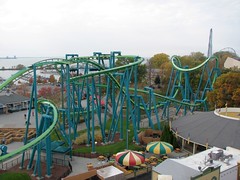 into the side of my restraint.
into the side of my restraint.
At the base of the zero-g roll is a small flat section of track that lasts for a second or so before curling up into the cobra roll. This is another one of those little ‘quirks’ you’d find in earlier B&M designs I wish they’d still include. It helps establish the pacing better than if it’s just a monotonous grind of constantly swooping down and back up between one inversion and the next with no change in flow whatsoever. Plus it helps generate a bit of anticipation for the cobra roll, allowing one to appreciate the roll itself a bit more once they get to it than if they had just been flung right into it without a chance to regain orientation after the roll.
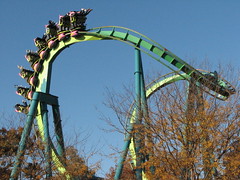 The cobra roll sort of mirrors the first two elements, at least in the way it mixes the vertical flip of the loop with the horizontal rotation of the zero-g roll while putting two elements back to back. The pace is also much faster here and is an effective coup-de-grace for the opening act before it starts to slow up. There’s much more of a whip at the top on the transition from loop to roll than would found on later inverted cobra rolls (with the possible exception of Alpengeist), and while sometimes this can lead to some unnecessary headbanging, it also lends an added aggressiveness to the maneuver that makes it very unpredictable. The positive g-forces are also smothered around the entire element and it’s not uncommon for your feet to tingle a little bit afterward.
The cobra roll sort of mirrors the first two elements, at least in the way it mixes the vertical flip of the loop with the horizontal rotation of the zero-g roll while putting two elements back to back. The pace is also much faster here and is an effective coup-de-grace for the opening act before it starts to slow up. There’s much more of a whip at the top on the transition from loop to roll than would found on later inverted cobra rolls (with the possible exception of Alpengeist), and while sometimes this can lead to some unnecessary headbanging, it also lends an added aggressiveness to the maneuver that makes it very unpredictable. The positive g-forces are also smothered around the entire element and it’s not uncommon for your feet to tingle a little bit afterward.
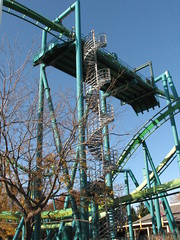 The opening act of the ride now complete, it fares pretty well compared to most other inverted coasters, so far having been a steady build-up in intensity through to the end of cobra roll similar to other great inverts such as Alpengeist or Afterburn (although I would rank both of those ride’s opening acts slightly above Raptor’s for various reasons). But this is where Raptor starts to differentiate itself from the rest of the pack. Needing to gain some altitude for a midcourse block brake, instead of choosing to simply climb a hill straight up the way Montu does, it instead takes the time to offer a moment of free-flight, a fun little s-curve between the supports before taking a slow carousel far above ground level into the brake run. With other inverts always so focused on sequencing one inversion immediately after another, it can easily overwhelm any sensation of flying that the
The opening act of the ride now complete, it fares pretty well compared to most other inverted coasters, so far having been a steady build-up in intensity through to the end of cobra roll similar to other great inverts such as Alpengeist or Afterburn (although I would rank both of those ride’s opening acts slightly above Raptor’s for various reasons). But this is where Raptor starts to differentiate itself from the rest of the pack. Needing to gain some altitude for a midcourse block brake, instead of choosing to simply climb a hill straight up the way Montu does, it instead takes the time to offer a moment of free-flight, a fun little s-curve between the supports before taking a slow carousel far above ground level into the brake run. With other inverts always so focused on sequencing one inversion immediately after another, it can easily overwhelm any sensation of flying that the 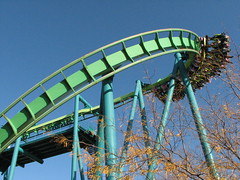 inverted coaster was designed for in the first place. While this lead-up into the brake run isn’t much, it’s still more than enough opportunity to show a different side to the overall ride, enjoying a brief moment of free-flight as the surrounding Cedar Point landscape slides around you, and at the same time forming a middle ‘interlude’ that’s formally distinctive from the rest of the experience, rather than in cases where it’s only a straight hill on either side of the midcourse which doesn’t distinguish it at all from the rest of the elements other than finding a sudden letdown in pace at the top instead of another zero-g roll.
inverted coaster was designed for in the first place. While this lead-up into the brake run isn’t much, it’s still more than enough opportunity to show a different side to the overall ride, enjoying a brief moment of free-flight as the surrounding Cedar Point landscape slides around you, and at the same time forming a middle ‘interlude’ that’s formally distinctive from the rest of the experience, rather than in cases where it’s only a straight hill on either side of the midcourse which doesn’t distinguish it at all from the rest of the elements other than finding a sudden letdown in pace at the top instead of another zero-g roll.
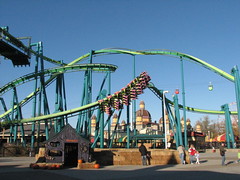 Off the other end of the midcourse, we mirror the way we got up the hill with another fun, sweeping helix, only this one a little steeper and more to-the-point. The speed quickly increases and there’s a brief moment at the bottom of anticipation from the regained potential energy before it explodes back into kinetic (at least in terms of g-forces and pace). The first flatspin can easily stand toe-to-toe against any of the ride’s first four inversions in terms of intensity, the uniformly fast rotation
Off the other end of the midcourse, we mirror the way we got up the hill with another fun, sweeping helix, only this one a little steeper and more to-the-point. The speed quickly increases and there’s a brief moment at the bottom of anticipation from the regained potential energy before it explodes back into kinetic (at least in terms of g-forces and pace). The first flatspin can easily stand toe-to-toe against any of the ride’s first four inversions in terms of intensity, the uniformly fast rotation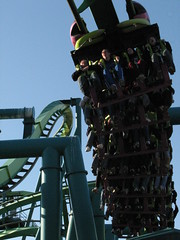 with an uber-quick ‘snap’ at the top no less forceful than the rollover in the middle of the cobra roll, and the timing is just as quick as well. There’s a moment to breathe with another drawn out flight near the midway. Honestly this moment would have been a dud if it weren’t for two things: the sustained speed which adds to the enjoyable ‘flight’ sensation, and how it leads into a banking increase before suddenly diving down to ground level, which sets up the finale quite well.
with an uber-quick ‘snap’ at the top no less forceful than the rollover in the middle of the cobra roll, and the timing is just as quick as well. There’s a moment to breathe with another drawn out flight near the midway. Honestly this moment would have been a dud if it weren’t for two things: the sustained speed which adds to the enjoyable ‘flight’ sensation, and how it leads into a banking increase before suddenly diving down to ground level, which sets up the finale quite well.
The final flat spin / corkscrew is just as intense as the one before it. That’s what I really appreciate about Raptor, these elements don’t get weaker as the ride goes on, these flatspins with the snap at the top and forceful rotational g-forces are just as relevant as the opening elements. There’s an awkward pause in the banking as it begins to anticipate the ride’s 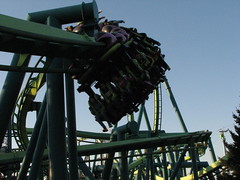 final maneuver, the downward helix.
final maneuver, the downward helix.
Until this point, Raptor has performed about as well as many other B&M inverts. I appreciate things like the elevated helix into the midcourse brake run that allows for a change of pace, but plenty of other B&M rides have their own special features that are easily cooler than that. However, on each of those other rides, once the final inversion is over they’re best off finding their path to the final brake run as quickly as possible because the pace only lets up afterwards and the longer it takes to wrap the layout up the more anticlimactic the ride is. What sets Raptor in a stratum several notches above the rest is the fact that the exact opposite is the case. While I might have a hard time deciding for sure,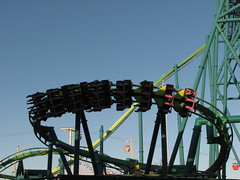 if I were to pick a favorite singular element on the ride, it would probably be this final helix. As I mentioned, the g-force / intensity range has been relatively consistent over the course of the entire ride so far, the last flat spin being about as white-knuckle as the first loop, and the same is true of this helix.
if I were to pick a favorite singular element on the ride, it would probably be this final helix. As I mentioned, the g-force / intensity range has been relatively consistent over the course of the entire ride so far, the last flat spin being about as white-knuckle as the first loop, and the same is true of this helix.
But not at first. It starts out slow and gentle, like those few moments of freeflight sensation mentioned earlier. “Hey, this is going to be a piece of cake!” The train continues its spiral around the back half of the helix and navigates sharply downhill. The centrifugal forces steadily accumulate, stretching our dangling legs taut. The last 1/3 of the helix holds us nearly parallel to the ground while the forces continue to increase, the blood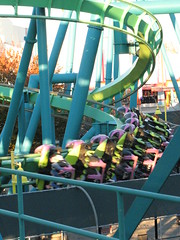 flow having difficulty getting to our heads and rushing towards our toes. Feel that tingle? Your body is no longer simply feeling the forces but is starting to display physical reactions to them. On a hot day when the train is really hauling around the course it can be a bit scary and lead to tunnel vision. Personally I still wish it could last just a moment longer but I understand the need to let up lest some riders with weaker constitutions start risk blacking out. Not only is this the most forceful element of the entire ride, but it’s also the longest lasting, and stands as a uniquely distinct centerpoint to the overall ride experience (the analytical nerd in me also wants to note how the layout comes full circle to mirror the first inversion in that it’s just sustained positives with no rotational interference).
flow having difficulty getting to our heads and rushing towards our toes. Feel that tingle? Your body is no longer simply feeling the forces but is starting to display physical reactions to them. On a hot day when the train is really hauling around the course it can be a bit scary and lead to tunnel vision. Personally I still wish it could last just a moment longer but I understand the need to let up lest some riders with weaker constitutions start risk blacking out. Not only is this the most forceful element of the entire ride, but it’s also the longest lasting, and stands as a uniquely distinct centerpoint to the overall ride experience (the analytical nerd in me also wants to note how the layout comes full circle to mirror the first inversion in that it’s just sustained positives with no rotational interference).
There’s one last left turn before the brake run… so much for the ride ending immediately after the big finale. But in actuality, I’m still engaged with the ride experience, and here’s why: the final transition out of this left turn and into the brake run is notoriously sudden and frequently quite painful. I’ll let the reader make their own decision on whether that’s a good or bad thing,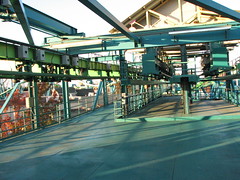 but at the very least it definitely shows that the ride is in control of the rider until the very last minute. On the turn leading up to this transition I always get a bit nervous and have to brace myself. Two out of three times it’s for nothing and we jolt into the brakes with no damage to my neck vertebrae, but I still get just enough bone-jarring snaps to always keep me on edge (I’ve not noticed any clear pattern but I do think sitting in the inside rows helps lessen the jostling). It’s not until after the ride is over and we’ve come to a complete stop that I’ve had a chance to inspect myself and determine if we’ve made it through this final maneuver unharmed that we’re finally released from the ride experience and can sit back and reflect on the whole thing as the train advances back to the station. On every other B&M coaster I’ve already started that reflection process
but at the very least it definitely shows that the ride is in control of the rider until the very last minute. On the turn leading up to this transition I always get a bit nervous and have to brace myself. Two out of three times it’s for nothing and we jolt into the brakes with no damage to my neck vertebrae, but I still get just enough bone-jarring snaps to always keep me on edge (I’ve not noticed any clear pattern but I do think sitting in the inside rows helps lessen the jostling). It’s not until after the ride is over and we’ve come to a complete stop that I’ve had a chance to inspect myself and determine if we’ve made it through this final maneuver unharmed that we’re finally released from the ride experience and can sit back and reflect on the whole thing as the train advances back to the station. On every other B&M coaster I’ve already started that reflection process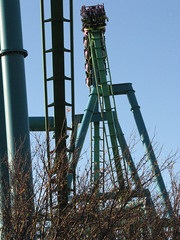 before I’ve even made it to the brake run, which a truly well-designed coaster should not allow (unless it’s somehow a deliberate artistic device, which I think it’s safe to say neither Claude nor Walter have ever intended). It is primarily for that reason that I continue to call Raptor B&M’s most successful inverted coaster even though many bolder and more ambitious rides have been
before I’ve even made it to the brake run, which a truly well-designed coaster should not allow (unless it’s somehow a deliberate artistic device, which I think it’s safe to say neither Claude nor Walter have ever intended). It is primarily for that reason that I continue to call Raptor B&M’s most successful inverted coaster even though many bolder and more ambitious rides have been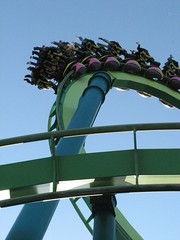 designed since it thrilled its first riders back in 1994.
designed since it thrilled its first riders back in 1994.
I’d be more than happy to be proven wrong; I do have to wonder how much of an influence 100 or so rides on it will be towards my final opinion over other rides. However, as long as we’re to accept the criteria outlined for a good riding experience as a valid one (i.e. consistent intensity/quality throughout, and one that keeps riders engaged with the riding experience all the way until the end instead of ending in anticlimax), then it should at least be factually provable that Raptor is indeed most successful at meeting these. Whether or not such things are personally as important to each individual reader as other factors such as a really forceful first half or near-miss collisions will invariably rely somewhat on personal tastes. As for my personal tastes… I’m a bit embarrassed I’ve had to establish such a basic, ‘traditionalist’ criteria for a good ride and would like to see an avant-garde response to such aesthetic rules one of these years, but at the moment I’ll take whatever I can get.
[1] Another possible exception is Apollo’s Chariot, which is able to more fully utilize the terrain and small design quirks in the second half that the first half doesn’t as strongly take advantage of. Others such as Kumba, Dominator or many of the stand-ups could also probably be contenders, and I’m sure some people out there would like to refute my assertion about B&M’s designs altogether; the comment box is directly below if that is the case for yourself.
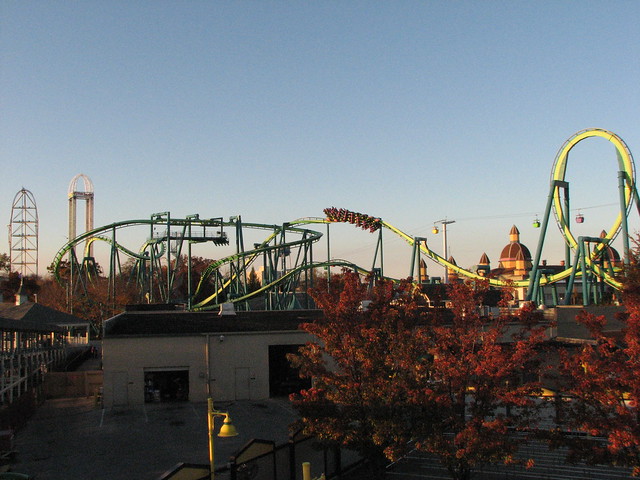
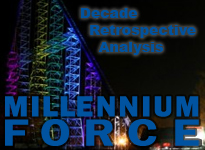
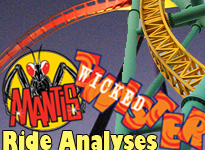

Comments